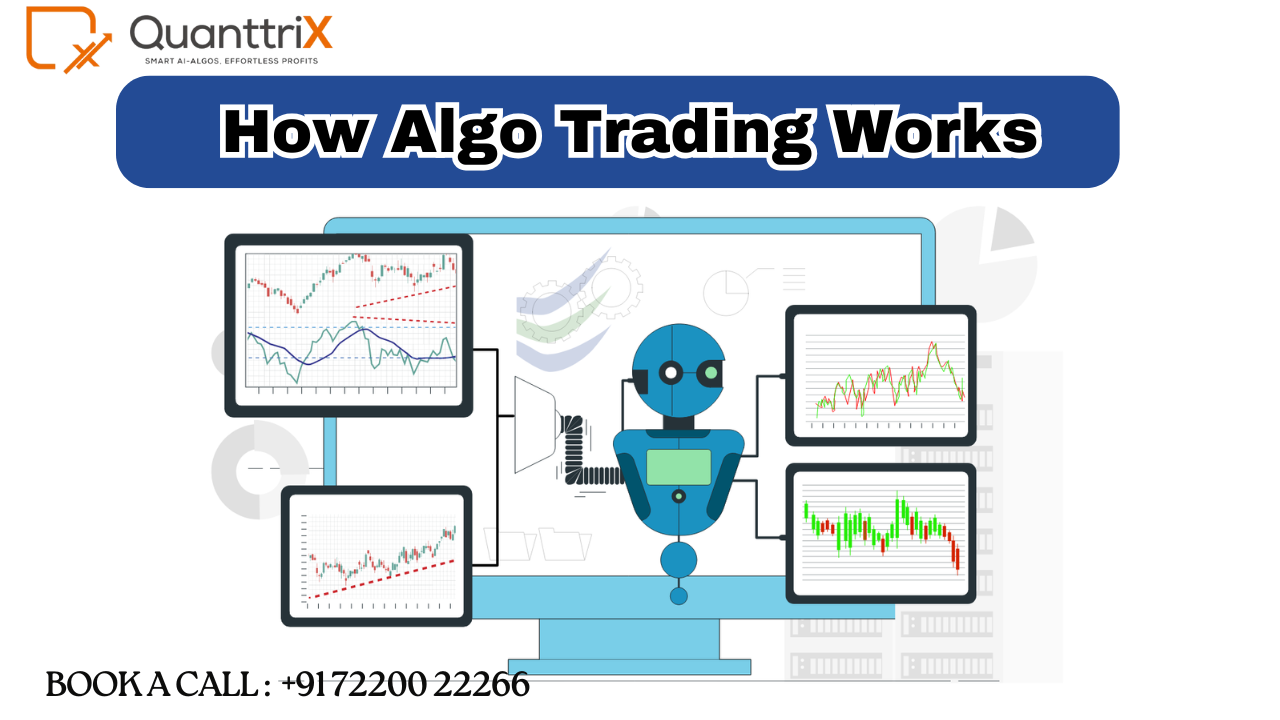How Algo Trading Works – Beginner’s Guide to Algorithmic Trading

How Algo Trading Works: A Beginner’s Guide
Introduction
Imagine if you could trade in the stock market without constantly staring at charts or manually placing trades. Sounds convenient, right? Well, that’s exactly what algorithmic trading (or algo trading) does for traders. It allows computers to execute trades on your behalf, based on predefined rules. But how does algo trading actually work?
Learn how algo trading works and what is algorithmic trading. Discover its benefits, risks, and how to start using automated strategies.
What is Algorithmic Trading?
Algorithmic trading, also known as algo trading, is the use of computer programs to automate trading decisions. These programs follow a set of predefined rules, analyzing market data and executing trades at high speeds.
How Does Algo Trading Work?
At its core, algo trading relies on mathematical models and historical data to make trading decisions. Here’s a simple breakdown:
- The trader designs a trading strategy.
- The algorithm scans market conditions.
- When criteria are met, it automatically places buy or sell orders.
- Trades execute within milliseconds, much faster than any human could.
Key Components of Algo Trading
Algo trading consists of several key elements:
- Trading Strategy – The logic behind buying and selling decisions.
- Market Data Feed – Live price data for accurate trade execution.
- Execution Platform – Software to place trades automatically.
- Risk Management – Ensuring losses are controlled.
Types of Algo Trading Strategies
There are different types of algorithmic trading strategies, including:
- Trend-Following Strategies – Based on moving averages and momentum indicators.
- Arbitrage Strategies – Exploiting price differences across markets.
- Market-Making Strategies – Continuously buying and selling to profit from the spread.
- Mean Reversion Strategies – Betting that prices will return to their historical average.
- Scalping – Making small profits on frequent trades.
Benefits of Algorithmic Trading
Why do traders love algo trading? Here are some key benefits:
- Speed – Executes trades in milliseconds.
- Accuracy – Reduces human errors in trading decisions.
- Efficiency – Can process massive amounts of data quickly.
- No Emotions – Eliminates psychological biases from trading.
Risks and Challenges in Algo Trading
Despite its benefits, algo trading comes with risks:
- System Failures – A glitch in the program can cause losses.
- Over-Optimization – Strategies may work in theory but fail in real markets.
- Market Risks – Unexpected volatility can impact automated trades.
How to Start with Algo Trading
Want to try algo trading? Here’s how to begin:
- Learn the Basics – Understand trading strategies and financial markets.
- Choose a Trading Platform – Find an algo-friendly brokerage.
- Develop a Strategy – Code or use pre-built strategies.
- Backtest Your Strategy – Test on historical data before live trading.
- Start Small – Begin with a demo account or small investments.
Best Practices for Success
To maximize success, follow these best practices:
- Keep It Simple – Avoid overly complex strategies.
- Monitor Performance – Regularly check if the algorithm is performing as expected.
- Use Stop-Losses – Protect against major losses.
Common Myths About Algo Trading
Let’s bust some common misconceptions:
- “Algo trading guarantees profits” – No strategy is foolproof.
- “Only experts can do it” – Many platforms allow beginners to use algo trading.
- “It’s illegal” – Algo trading is perfectly legal when done within regulations.
Future of Algorithmic Trading
Algo trading is evolving with advancements in AI and machine learning. In the future, expect:
- More sophisticated AI-driven strategies.
- Increased use of high-frequency trading.
- Stricter regulations for transparency and fairness.
Conclusion
Algorithmic trading is revolutionizing the financial markets by enabling faster and more efficient trading. While it offers several advantages, it also requires careful strategy selection and risk management. Whether you’re a beginner or an experienced trader, understanding how algo trading works can help you make informed decisions in today’s fast-paced trading environment.
This article provides a detailed yet simple explanation of how algo trading works and what is algorithmic trading while ensuring it is engaging and SEO-optimized.
FAQs
Is algo trading profitable?
Yes, but profitability depends on the strategy, market conditions, and proper risk management.
Do I need programming skills for algo trading?
Not necessarily. Many platforms offer ready-to-use algo trading tools, but coding skills help in customizing strategies.
What software is used for algo trading?
Popular algo trading software includes MetaTrader, NinjaTrader, and QuantConnect.
Is algo trading legal?
Yes, algo trading is legal, but it must comply with financial regulations.
Can beginners start algo trading?
Absolutely! Many brokers offer user-friendly algo trading tools for beginners to get started.



